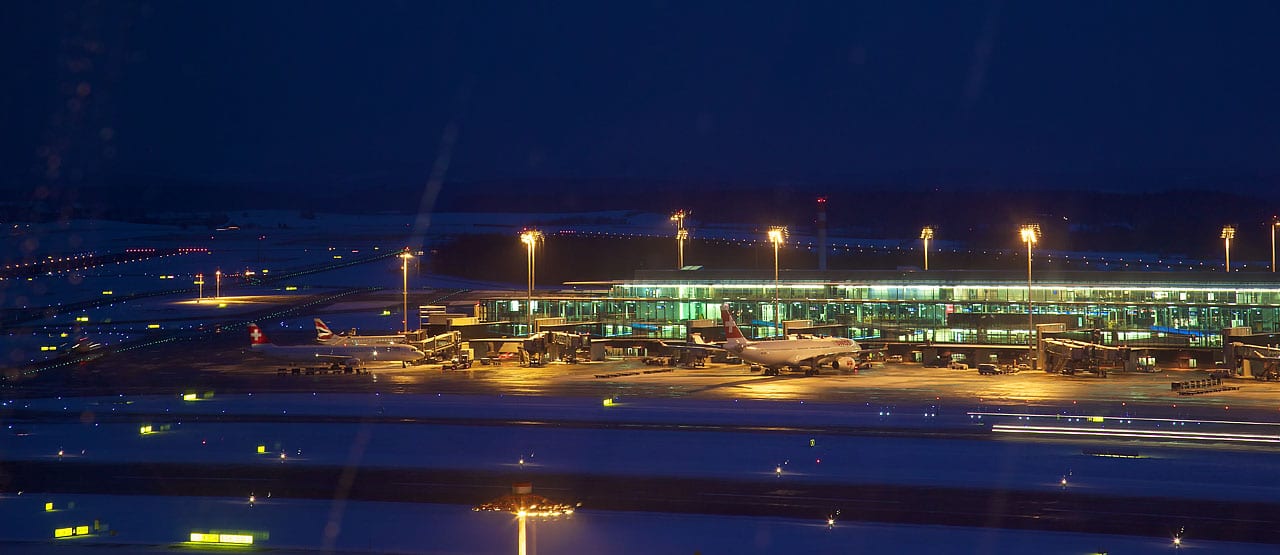
Geneva Airport in Switzerland could soon benefit from the introduction of virtual centers for air traffic management in Europe. (Skyguide)
Some of the largest air navigation service providers (ANSPs) and air traffic technology suppliers in Europe believe that the establishment of new “virtual centers” are the key to improving the way commercial and military flight operations are handled across borders by the region’s fragmented air traffic management system.
The improvement of the way cross border airspace is managed has been a goal for ANSPs in Europe for several decades. While the European Union Aviation Safety Agency (EASA) and Eurocontrol provide regulatory and air traffic management services to the region, each individual nation-state still has its own ANSP and civil aviation regulator responsible for its own airspace. Little to no sharing of data occurs across borders under the current structure.
Implementing virtual centers and dynamic airspace reconfiguration was first introduced as a way of improving cross-border flying in the Single European ATM Research Joint Undertaking (SESAR) JU’s March 2019 Airspace Architecture Study (AAS). SESAR JU describes the virtual center as a concept that involves transforming the way ATM data services, such as flight data, radar, and weather information are ultimately shared between physical individual air traffic controllers and other stakeholders across the ATM ecosystem.
Europe’s current air traffic system features decision-making based solely on the individual air navigation service providers in each European nation-state, where data is made available based on the decisions of the individual ANSPs and where needed, ANSPs are given control over adjacent airspace to the flight information region (FIR) that they’re responsible for.
Under the vision for virtual centers, the currently fragmented structure would be decoupled and transitioned to the development of a new data servicing system where individual Air Traffic Service Units (ATSUs) work in tandem with ATM Data Service Providers (ADSPs) that provide flight data processing functions like flight correlation, trajectory prediction, conflict detection and resolution, and arrival management planning.
This new way of providing services will be created by integrating services for weather, surveillance, and aeronautical information which today is individually analyzed and controlled by ANSPs based on each individual European country rather than being made available to all users across the network.
Representatives from the ANSPs that manage air traffic for Italy and Switzerland explained during SESAR JU’s recent “Digital Academy Webinar on Virtual Centers,” explained how they envision an eventual transition to the use of virtual centers working in Europe. Thomas Buchanan, senior adviser for international and public affairs for Skyguide – Switzerland’s ANSP – said that the adoption of the virtual center’s concept will also help them become more flexible toward accepting new sources of aviation data.

SESAR JU’s overview of what services a virtual center will provide. (SESAR JU)
“What we’re transitioning toward is the creation of data centers that are location independent, we’re going to be using the data center in Zurich to transfer data to both of our area control centers, west, and east. We will reuse the other data center as a cold standby to be able to come in as a contingency to the first data center should it fail. We also have external data from two sources, one of them being [French ANSP] DNSA as the prime source, and a redundant data service provision that is going to come in from [Italian ANSP] ENAV on cloud services,” Buchanan said.
As Buchanan further explained, Switzerland’s airspace management structure is reflective of other areas in Europe as well. Skyguide has responsibility for sections of French airspace that it manages in coordination with DNSA. He described the current structure as “easy to manage,” but that it becomes complex whenever there is a consideration for a new source of airspace data. Examples of this would be the use of Automatic Dependent Surveillance Broadcast or position reports coming from some military aircraft or even new and emerging airspace users such as drones and urban air mobility vehicles.
“In the new model that we set up, we have an enterprise service bus which serves as an interface between all the components, and also generates necessary data between the enterprise service bus and the controller working position, for that we no longer have to refer to them as the west or the east ATCs, they’re just connected CWPs and never mind where they’re located. If a new kind of data comes in, this data will be hooked up to the enterprise service bus and the component needed to generate or transfer or use this data inside the data center will also be connected and make the whole interconnected flow between the various components a lot easier,” Buchanan said.
SESAR JU’s AAS has a three-phased plan for transitioning to the implementation of virtual centers, occurring from now until 2035 split into five-year increments. Between 2020 and 2025, ANSPs who are onboard will be working on an enabling framework for the ADSPs, initially focusing on a “capacity-on-demand” service while developing standards and official certification procedures for the future ADSPs. By 2025 the group has envisioned the implementation of the new virtual centers and dynamic airspace configuration as well.
However, Buchanan and other experts featured on the recent webinar admit that the transition will not be easy. In September, Eurocae established its new Working Group 122 (WG-122) “Virtual Center,” tasked with the development of standards in support of future virtual centers.
In October 2019, SESAR led a live demonstration of what a future virtual center could look like featuring 100 total participants witnessing seven ANSPs transferring airspace and flights between each other. The demonstration validated the concept and showed how virtual centers can enable increased flexibility for flight operations and workload balancing across European airspace.
“Virtual Centers are already a reality. Activities are ongoing in various locations in Europe. Where the current work is needed is the more dynamic allocation of the EU Airspace across the various ANSPs. This will be the work to be done in the next few years,” Buchanan said.